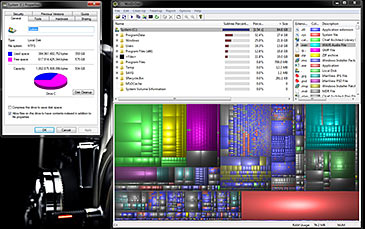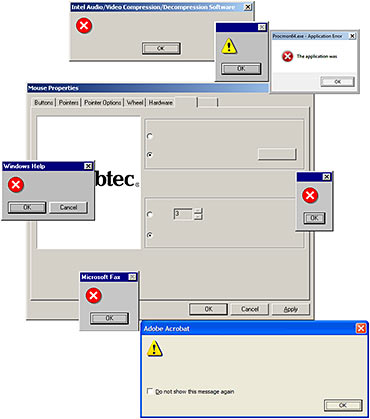
Atomic I/O letters column #153
Originally published 2014, in PC & Tech Authority(in which Atomic magazine is now a section)
Reprinted here December 10, 2014 Last modified 16-Jan-2015.
Mysterious gigs
I recently purchased a Samsung SSD (111Gb formatted) to speed up the boot process on my Win 7 desktop. When trying to clean up the C drive to get it to a reasonable size before using the clone tools I encountered the problem of "invisible files".
That is, I have 85Gb in the C drive that I can see via Explorer and other tools, but 358Gb of reported use. I have tried everything I can think of to remove system files, page files, disc clean-ups, etc. without any success. I do not really want to start from scratch with a system build, so would be interested in any advice as to what the extra capacity would be used by.
I have included snapshots of the system and disc details.
Peter

What's 271 gigabytes between friends?
Answer:
Presuming you don't have some kind of malware that's secretly making you a leading world
source of pirated pornography and no-subscription-needed Adobe software, there aren't
many kinds of hidden file that can add up to such a large amount of data. Few system
files can be anything like this big. As you say,
swap
files could add up to that
much, as could temp files for certain highly data-intensive applications like video
editing. But the usual suspects only add up to tens of gigabytes, at most.
(A Windows hibernate file, for instance - hiberfil.sys - will only be the size of your physical RAM. Well, it always used to be that size, but now it can be compressed and/or forced smaller with the "powercfg" console command but you probably don't actually want to do that and it's not relevant to your question so I'll close these parentheses now.)
WinDirStat, which you're using to see what's on your drive, won't enumerate the size of stuff in folders the logged-in user doesn't have permission to view, which can amount to a lot on a multi-user computer. WinDirStat also doesn't notice stuff in the Recycle Bin, which can be quite large, but obviously you've emptied it. About the only suspect left is slabs of data created by the System Restore and/or Shadow Copy services.
These services are what let you roll back Windows to how it was before some new driver installation or buggy uninstaller hosed the system, but the price you pay is ever-increasing amounts of data, all of it "super-hidden" in the System Volume Information folder. You can view super-hidden files in Explorer by turning off the good old Folder Options -> View -> Hide protected operating system files (Recommended) option, but this still doesn't guarantee that any given folder-size-displaying program will notice them. (It is in fact possible for a well-matured years-old Windows 7 system to report less disk utilisation when you make super-hidden files visible. Don't ask me how.)
Anyway, if your computer's currently working OK and you've no need to roll it back, you can turn off the System Restore and Shadow Copy stuff (manually in services.msc, if you want to be bossy), and then if you make the files visible you should be able to delete them. It may also be possible to get the imaging software to just ignore them, rendering this whole answer redundant. But at least now I hope I've given you some useful clue about what the heck is eating up your disk space.
It's for jump-starting the lunch room
At my office, we have Ethernet wall sockets, but in three rooms there's one double socket and one single socket by the door, with one socket on the double plate connected to the single plate by a short patch lead.
The other socket on the double plate goes to a little switch that feeds the computers in the room, but if you unplug the patch lead, you unplug the room from the network. Computers in the room can still see each other (unless you restart one and it now can't get an IP address etc), but they can't see the rest of the network any more.
I'm trying to work out why this is wired this way, and also wondering if it breaks a law (we're in Adelaide, if it matters) or may be indicative of other crazy stuff inside the walls. The building was wired about four occupants ago and nobody seems to know what the deal is. Should I be worried?
Caleb
Answer:
Probably not.
This sort of setup is a simple way to make it possible to easily manually disconnect a room from the wired network, generally for security purposes of some sort - confidential stuff on the computers in that room, students doing exams on computers, that sort of thing. It's less useful now that wireless networking is so ubiquitous, but it's still pretty common, particularly in schools.
I strongly doubt that it breaks any laws. Your office does still have the normal, entertainingly high, chance of apparently having been wired by frightened felines shoved into the walls and ceilings with cut-rate Ethernet cable tied to their tails.
(That's why they call it Cat5, of course. Only recently have network installers managed to use six cats at once without losing one in there.)
Is a failed hotkey a coldkey?
They've discontinued Winamp but I'm still using it, because it's not as if there's a new MP7 audio format I have to keep up with or anything. But right after the End Of Winamp was announced I got a brand new problem with the player, which I think might be related.
The problem's only small: Alt-3 to show the properties and tags and such of the selected file doesn't work any more. Right-click and then "View file info..." works, but the Alt-3 shortcut shown right there on the menu next to that option does not.
I rebooted (Win7, 64-bit) and then it worked again... for a while, but then stopped again.
Is this discontinued software... falling into disrepair?
Sean

The classic symptom of running out of memory is that the computer can't quite
tell you what's wrong any more.
Answer:
A little later, Sean e-mailed me again to inform me that when he quit out of Firefox,
Alt-3 worked again. When he ran the browser again, it didn't. A couple of experiments
later, I verified that the fault was... lack of memory. Or possibly one of the other
memory-like limited resources in Windows, like "handles",
and the "desktop heap".
Running out of memory is one of the Two Great Problems that can manifest in a very wide variety of bizarre ways, because they're so fundamental to the operation of pretty much the whole system. (The other Great Problem is a flaky power supply.)
A computer that's out of memory, or out of some system resource that works in a similar way, can indeed just silently stop being able to do certain things, and not be able to tell you what's wrong. (It may help you to think of it as a child who's so upset they're unable to tell you what's upsetting them.)
This happens either because the resource the computer's out of is one that it'd need more of to pop up an error box, or because programmers didn't test their software on a PC with (say) 150 browser windows open, or heavy-duty video effects generation happening in the background, or whatever. Random features silently not working any more are a classic symptom of low memory.
Besides things just not working, and other obvious stuff like malformed windows lacking the normal furniture, recently on my own computer I saw a low-memory condition cause YouTube to only be able to "maximise" to the top left quarter of the screen. If you didn't pick that as being memory-related, you could go on a fruitless safari through video drivers, browser plugins, reinstalling Flash...
You'll need a pneumatic scaler, jackhammer, or Channel Tunnel boring machine
Is it actually possible to "delid" a CPU for better cooling? I'd never heard of this until my nephew (aged 12) mentioned it, and I strongly suspect he's trying to trick his idiot uncle into taking to his computer with an angle grinder.
On the other hand, though, I remember when CPUs had just a plain silicon surface on top (hell, I remember when CPUs didn't need fans!), and now they all seem to have metal caps over the chip, which I presume are there to protect it and which I also presume could in theory at least be removed and thus get rid of one extra heat-blocking thermal contact point.
I've got an Intel CPU with a K on the end of its name which I think actually could run faster with better cooling - but is this about as practical as submerging the whole computer in liquid nitrogen?
Tom
Answer:
Yes, it actually is possible to get better cooling by delidding certain CPUs.
It is, simultaneously, about as risky as you suspect.
The whole idea of putting metal heat-spreaders on the top of a CPU package is, as you say, to protect the small and fragile silicon from the force of a heat-sink being cranked down on top of it. (The corners got ground off a lot of poor little exposed-die Celerons and Pentium IIIs and Durons, back when they were prime overclocking material and often saddled with big heavy heat-sinks.)
The thermal interface between the chip and the spreader is supposed to be a very good one. But in some CPUs, including fancy Intel Ivy Bridge and Haswell units, it actually isn't. For ease and cheapness of manufacturing, the chip-to-spreader contact inside is a pretty sloppy one, with thermal goop of no particular merit filling the gaps.
This goop does not need to actually stick the CPU to the spreader, since the whole point is that the cap is held on around the edges to help protect the chip. So alarming exercises with razor blades or, I kid you not, a bench vise, a chunk of wood and a claw hammer, can quite easily pop off the spreader without damaging the chip.
The challenge now is to get a heat-sink onto that chip without damaging it. If the heat-sink is a slim little water-block, you'll probably be OK. If it's a copper skyscraper, though, not so much. Many current delidders just replace the Intel thermal goop with better goop, polish down the top of the spreader for better contact, and put the spreader back on. Otherwise you'll need a shim to put around the exposed die to take some of the pressure from the heat-sink.
A lousy thermal contact inside the package, for stock-speed CPUs in a passably ventilated case with unremarkable ambient temperatures, works fine. Most CPUs don't run at anything like their full electrical power most of the time, and modern CPUs reduce their clock speed when full power is not required, or (importantly) when they sense themselves overheating. This last feature can cover up an awful lot of temperature problems; modern CPUs can bounce off the thermal limiter without dying for, literally, years.
For everyday computing tasks the user won't even notice if the CPU's thermal-throttled itself down, though the effect may be very obvious in high-CPU-load tasks like 3D games or non-GPU-accelerated HD video playback.
If the heat-spreader's got a good thermal contact with the CPU, though, then there's a limit to what delidding can get you, and a considerable chance of mechanically damaging the processor. This is one of those jobs you only know how to do after you've done it... but will have forgotten by the time you need to do it again.

